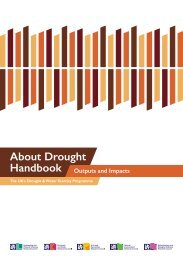DelegatePack_DroughtConference_20-21March2019
You also want an ePaper? Increase the reach of your titles
YUMPU automatically turns print PDFs into web optimized ePapers that Google loves.
Posters<br />
Sevilay Topcu Cukurova University<br />
Strategic Comparison of Past and Future Droughts in Turkey<br />
Turkey is strongly and increasingly exposed to drought. Historically, serious droughts occurred as in 1804 and 1876<br />
causing the loss of agricultural production and livestock as well as the migration of affected farmers. Drought-related<br />
famines and diseases in 1876 claimed an estimated <strong>20</strong>0,000 lives. More recently, serious drought events occurred in<br />
1928, 1973, 1989, 1990, 1993, 1998-<strong>20</strong>01, <strong>20</strong>07, <strong>20</strong>08, <strong>20</strong>13 and <strong>20</strong>17. The present study analyses i) the spatial and<br />
temporal dimensions of historical droughts in Turkey, ii) to predict the potential intensity, frequency and duration of<br />
droughts for the future (<strong>20</strong>70-2100) iii) to compare the past and future drought occurrences with a view to developing<br />
appropriate mitigation and adaptation strategies. We used the Standardized Precipitation Index (SPI) to assess drought<br />
characteristics. Rainfall datasets for the reference period, 1960-1990, were acquired from 51 stations (representative<br />
of regions with different rainfall regimes in the country) of the Turkish State Meteorological Service. The future rainfall<br />
series for the <strong>20</strong>70-2100 period were simulated using a regional climate model (RegCM4) for IPCC’s SRES-A2 scenario<br />
conditions. To determine the likely changes between reference and future periods, the projected future rainfall series<br />
was compared with the average rainfall amount derived from the reference period in SPI calculations. Finally, maps<br />
were drawn to determine the changes in spatial patterns of droughts. The study results showed that drought<br />
conditions are diverse in Turkey, and increasing trends for intensity, frequency and duration were detected. At<br />
regional scale, the Eastern part of Marmara, Black Sea Region and northern and eastern parts of the East Anatolia<br />
Regions are characterized by wetter conditions. Particularly severe drought conditions are expected in the Western<br />
Mediterranean and Aegean Regions, although other regions of the country will also likely be confronted with more<br />
frequent, intense and long lasting droughts. Most rain-fed and irrigated areas and surface water resources are located<br />
in the drought-vulnerable regions of the country. Industrial, touristic, urban and other water uses will also be affected<br />
by the worsened conditions in Turkey. Results of this and similar studies have been integrated into the national<br />
drought strategy and action plans to combat desertification and drought in Turkey.<br />
Harry West, Nevil Quinn, Michael Horswell & Paul White UWE<br />
Examining spatial variations in the utility of SPI as a 3-month-ahead environmental drought<br />
indicator<br />
Droughts are a common meteorological phenomenon and a significant natural hazard. Despite this we lack a common<br />
understanding of the definition of a drought event and a detailed understanding of drought onset and termination. In<br />
its simplest form however a drought can be defined as a deficit of rainfall relative to normal conditions. This rainfall<br />
deficit will eventually propagate through the hydrological system into terrestrial water storage and streamflow. Using<br />
the latest available hydro-meteorological datasets from the UK Droughts & Water Scarcity Programme, this paper<br />
aims to examine the relationship between rainfall deficit (quantified by the standardised precipitation index for a range<br />
of accumulation periods ranging from 1 to 12 months) and environmental drought (quantified by the standardised<br />
streamflow index) in 303 catchments across Great Britain. Through this we identify the rainfall deficit accumulation<br />
periods that are associated with the more severe environmental droughts, and in doing so identify the role of local<br />
catchment characteristics (quantified by the base flow index) in moderating drought frequency and severity. By<br />
developing a spatial understanding of the relationship between rainfall deficit accumulation and environmental drought,<br />
we identify and map the variation in critical SPI accumulation thresholds for estimating environmental drought risk<br />
over the forthcoming 1 to 3 months. The intention is that this will provide water resource managers with a simple tool<br />
to aid effective decision making in drought event management.<br />
Jie Xiang, Martin Hare, Ivan Grove & Peter Kettlewell<br />
Harper Adams University<br />
Understanding mitigation of drought damage to rapeseed from spraying film<br />
antitranspirants<br />
Considering predicted impacts of climate change, the expansion of rapeseed in the major producing countries in<br />
temperate regions, where it is well-adapted, has been reinforcing the need for future tolerance to abiotic stresses such<br />
as water deficit. A number of studies have shown that drought has been exacerbated by climate change with multiple<br />
effects on agriculture, particularly in arid and semi-arid regions. Rapeseed (Brassica napus L.) has become the third<br />
most important oilseed crop around the world for edible oil, fodder and biofuel production after soybean (Glycine<br />
max L.) and palm oil (Elaeis guineensis L.). It is more sensitive to water stress compared to other crops such as wheat<br />
and barley, especially at its critical reproductive stages. There is increasing evidence that film antitranspirants can<br />
improve the yield of crops subjected to drought compared to unsprayed treatments. Nevertheless, the mechanisms by<br />
which antitranspirants can mitigate against yield loss are not clear. Therefore, a series of experiments will investigate<br />
the underlying mechanism by which film antitranspirants increase the yield of rapeseed under drought conditions,<br />
especially the stomatal functions. Additionally, the data will be related to the mathematical models of gas exchange<br />
from the stomata to exploit the role of film antitranspirants on the regulation of gaseous exchange in rapeseed.




